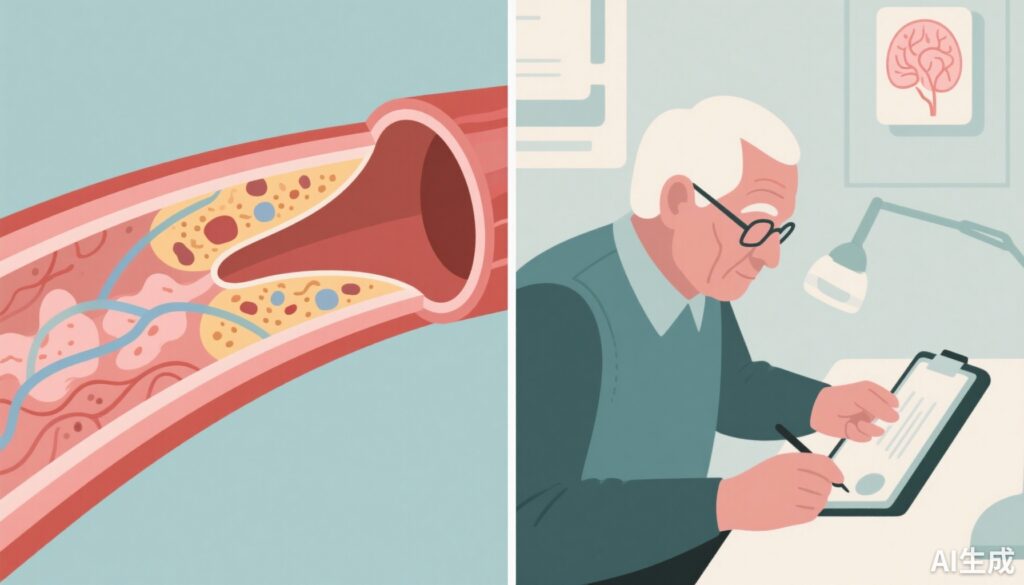Highlights
• In the Multi‑Ethnic Study of Atherosclerosis (MESA), baseline composite measures of arteriosclerosis and atherosclerosis were more consistently associated with cognitive decline and incident cognitive impairment (MCI/dementia) over 20 years than composites of blood pressure or cardiac function.
• Associations were observed across cognitive domains and racial/ethnic subgroups and persisted after accounting for clinical dementia risk factors.
• Findings support vascular aging—particularly arterial stiffness and atherosclerotic burden—as plausible upstream contributors to late‑life cognitive impairment and a target for prevention.
Background
Dementia and milder cognitive disorders impose a growing public‑health burden worldwide. Vascular contributions to cognitive impairment and dementia (VCID) are increasingly recognized as common, often coexisting with neurodegenerative pathology. Subclinical vascular abnormalities—manifestations of vascular disease detectable before overt clinical events—offer a window into processes that may precede or accelerate cognitive decline. Identifying which aspects of subclinical vascular burden best predict later cognitive impairment can sharpen mechanistic models and refine prevention strategies.
Study design and methods
The Multi‑Ethnic Study of Atherosclerosis (MESA) is a prospective cohort study that enrolled 6,814 men and women free of clinically manifest cardiovascular disease at baseline and followed them with repeated examinations for up to 20 years. At baseline, participants underwent a comprehensive battery of vascular assessments (including measures of atherosclerosis, arterial stiffness/arteriosclerosis, blood pressure, and cardiac structure/function).
Investigators used factor analysis to combine baseline vascular measures into four largely uncorrelated composite factors that capture distinct pathophysiological domains: (1) atherosclerosis (for example, coronary calcium and carotid plaque), (2) arteriosclerosis (measures of arterial stiffness and pulse‑wave velocity), (3) blood pressure (clinic and ambulatory indices), and (4) cardiac function (echocardiographic indices of myocardial structure and function).
Cognitive testing began roughly 10 years after baseline and was repeated twice over the subsequent decade. Detailed neuropsychological testing allowed domain‑specific assessment (memory, executive function, processing speed, language, etc.), and clinical adjudication identified cases of mild cognitive impairment (MCI) and dementia. The analysis related baseline vascular composites to subsequent cognitive performance, longitudinal change, and adjudicated clinical outcomes, adjusting for demographic variables, education, and clinical dementia risk factors.
Key findings
The central findings of the study are straightforward and clinically salient.
1. Arteriosclerosis and atherosclerosis composites predicted later cognitive decline
Higher baseline scores for both arteriosclerosis and atherosclerosis were associated with worse cognitive performance measured 10–20 years later and with greater rates of decline across the follow‑up assessments. Associations were observed across multiple cognitive domains rather than being restricted to a single test or ability.
2. Arteriosclerosis showed the most consistent relationships
Of the four composites, the arteriosclerosis factor—reflecting arterial stiffening—was most consistently associated with poorer cognitive outcomes. This pattern held for global cognition, processing speed, and executive function domains, all of which are commonly impacted in vascular cognitive impairment.
3. Atherosclerotic burden also associated with impairment
The atherosclerosis composite, capturing subclinical plaque burden, independently predicted poorer cognition and higher odds of adjudicated MCI and dementia later in life. These associations suggest that large‑artery atheroma may contribute to chronic brain hypoperfusion, microembolization, or downstream small‑vessel injury that manifests clinically years later.
4. Weaker, less consistent associations for blood pressure and cardiac function
Baseline composites representing blood pressure and cardiac function showed weaker and less consistent relationships with subsequent cognitive outcomes. These factors did not perform as robustly as arteriosclerosis and atherosclerosis after multivariable adjustment, though this does not exclude clinical relevance—timing, measurement variability, and treatment of blood pressure over the life course may modify observed associations.
5. Robustness across subgroups
Stratified analyses by race/ethnicity and other demographic factors indicated that the observed associations generalized across subgroups, though the magnitude and domain specificity sometimes varied. Importantly, the relationships persisted after adjustment for clinical dementia risk factors, bolstering the interpretation that subclinical vascular pathology contributes information beyond traditional risk factor profiling.
Clinical and biological interpretation
These results add longitudinal, population‑based evidence that subclinical vascular disease—particularly arterial stiffening and atherosclerotic plaque—predicts late‑life cognitive decline and clinically adjudicated cognitive impairment. Potential biological mechanisms include chronic cerebral hypoperfusion due to impaired compliance of large arteries, increased pulsatile flow damaging the cerebral microvasculature, endothelial dysfunction, and microembolization from unstable plaques. Arterial stiffness preferentially impacts frontal‑subcortical circuits involved in processing speed and executive function, which aligns with the observed domain pattern.
Expert commentary and implications for practice
From a clinical vantage point, these findings reinforce an integrated cardio‑cerebral perspective: vascular aging is not only a risk for myocardial infarction and stroke but also for progressive cognitive loss. The study supports the concept that assessing subclinical vascular health—beyond measuring clinic blood pressure—may improve risk stratification for future cognitive decline.
However, translating these observations into practice requires caution. The MESA analyses are observational; while temporally convincing, they cannot establish causation. Moreover, pragmatic questions remain: which subclinical tests should be widely deployed, at what ages, and would interventions directed by such measures meaningfully reduce dementia incidence beyond standard risk management?
Strengths and limitations
Strengths of the study include a large, multi‑ethnic cohort free from clinical cardiovascular disease at baseline, detailed and diverse vascular phenotyping summarized into physiologically meaningful composites, long follow‑up with repeated cognitive assessments, and adjudicated clinical outcomes. These design features enhance both internal validity and relevance to diverse populations.
Limitations include the observational design and potential for residual confounding despite adjustments. Vascular measures were taken at baseline and may not capture lifetime exposure trajectories or changes due to treatment. Cognitive testing began a decade after baseline; thus, early cognitive trajectories or reverse causation in the interim cannot be fully excluded. Survivor bias is another consideration—participants who remained in the study and completed late cognitive testing may differ systematically from those lost to follow‑up. Finally, while composites aid interpretation by aggregating related measures, they can mask heterogeneity within component measures.
Research and policy implications
These findings motivate several priorities for research and policy:
- Interventional trials that target arterial stiffness and atherosclerotic progression (for example, intensive blood‑pressure control, lifestyle interventions, novel pharmacotherapies) with cognition and incident dementia as prespecified outcomes.
- Life‑course studies that integrate serial vascular phenotyping and neuroimaging to clarify temporal relationships and mechanisms (e.g., linkage of arterial stiffness with white‑matter hyperintensities, microinfarcts, and perfusion deficits).
- Evaluation of pragmatic screening strategies—identifying which subclinical tests (pulse‑wave velocity, coronary calcium, carotid imaging) provide additive predictive value for cognitive outcomes when combined with established risk calculators.
- Equitable research and care delivery to ensure findings apply across racial/ethnic and socioeconomic groups, given heterogeneity in vascular risk exposure and access to care.
Conclusion
The MESA results underscore that subclinical vascular burden—especially arterial stiffness and atherosclerotic plaque—predicts long‑term cognitive decline and clinical cognitive impairment across a diverse population. These data strengthen the rationale for vascular‑targeted prevention strategies as part of dementia risk reduction. Clinicians should continue to prioritize vascular risk factor control across adulthood, while investigators pursue trials and mechanistic studies to confirm whether modifying subclinical vascular disease can prevent or delay cognitive decline.
Funding, registration, and reporting
Funding and trial registration details are reported in the original MESA publications. Readers should consult the cited MESA report (Tanley et al., Alzheimers Dement. 2025) for full information on funding sources, institutional review, and data‑access statements.
Selected further reading
For readers seeking additional context: cohort studies such as Framingham, ARIC, and Rotterdam have previously linked vascular risk factors and subclinical markers to cognitive outcomes. Randomized trials (e.g., SPRINT MIND) have evaluated blood‑pressure control and cognition. Mechanistic reviews on arterial stiffness and brain aging summarize plausible pathways linking vascular aging to cognitive decline.
Thumbnail image prompt
Create an infographic‑style thumbnail: left half shows a cross‑section of an artery with plaque and a stylized pulse wave indicating stiffness; right half shows an older adult (diverse racial background) performing a brief cognitive test with a clinician. Muted clinical palette, clear labels “arterial stiffness” and “plaque,” high realism, balanced composition.



